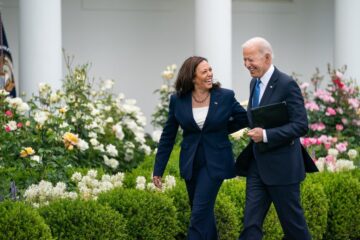Welcome back to Week 55 in my weekly reports analyzing the Covid-19 pandemic and its effects on the country and higher education. For those of you reading this on my blog, Off the Silk Road, I have also launched a newsletter, where these reports can be sent directly to your email each week. Click here to subscribe.
Last week, we examined the “vaccine enthusiasm frontier” as many states are currently seeing thousands of available appointments and many communities remain largely unvaccinated. This week, we will continue to look at the state of vaccinations as India battles a crisis of monstrous proportions.
A national look
We are now seeing a new form of the split screen pandemic — as cases in the U.S. continue to decline, India is currently experiencing the world’s outbreak, with daily cases topping 400,000. In a total failure of government to protect its own citizens, Indians are facing severe shortages of oxygen and other supplies. “Everywhere your camera turns we are seeing death,” CNN anchor John Berman said to a CNN team on the ground. It’s “nothing short of an apocalypse,” Dr. Farah Husain, head of a Covid-19 ICU unit at a hospital in India, told CNN. The United States is delivering supplies worth more than $100 million in the coming days to provide urgent relief to India, including oxygen concentrators, vaccine materials and test kits. But it’s not enough. This month, the crisis in India is only expected to worsen, as Dr. Anthony Fauci told Indian Express he would recommend shutting the country down for a few weeks until infections subside. Members of the Indian diaspora in the United States work day and night to help their struggling relatives. Our thoughts go out to all in India battling Covid-19. An outbreak anywhere is an outbreak everywhere, as cases in countries surrounding India have also increased.
The first of several emergency COVID-19 relief shipments from the United States has arrived in India! Building on over 70 years of cooperation, the United States stands with India as we fight the COVID-19 pandemic together. #USIndiaDosti pic.twitter.com/OpHn8ZMXrJ
— U.S. Embassy India (@USAndIndia) April 30, 2021
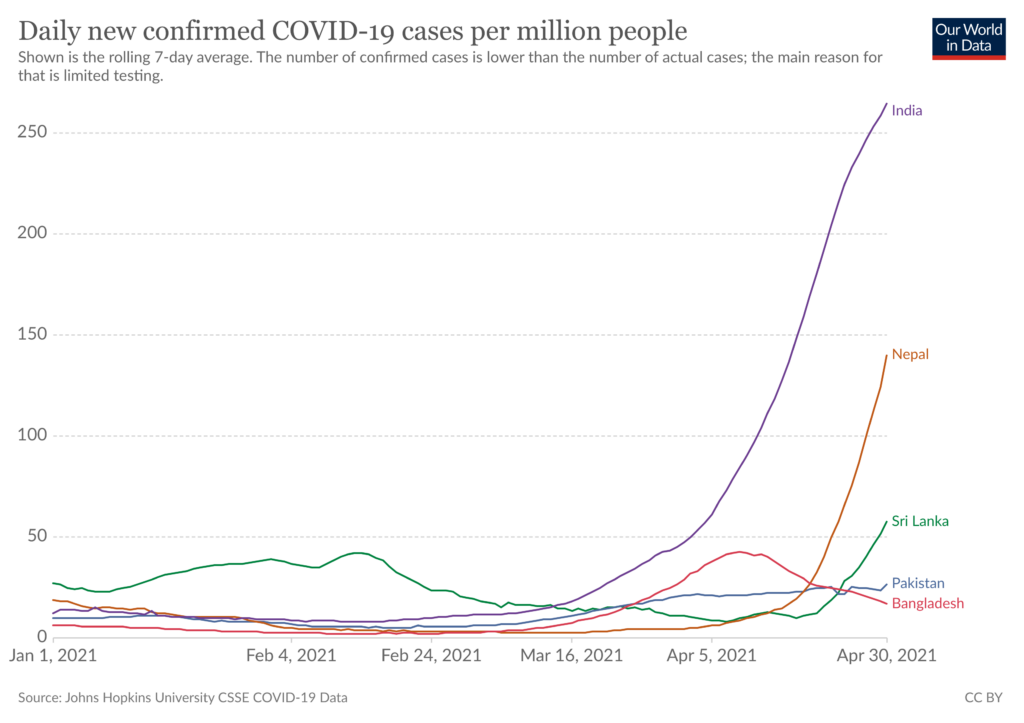
Let’s take a look at some of the latest scientific developments:
- The CDC updated its guidance for fully vaccinated individuals, stating that they do not have to wear a mask outside unless they are in a large group. Expect the guidance to change as more Americans are vaccinated.
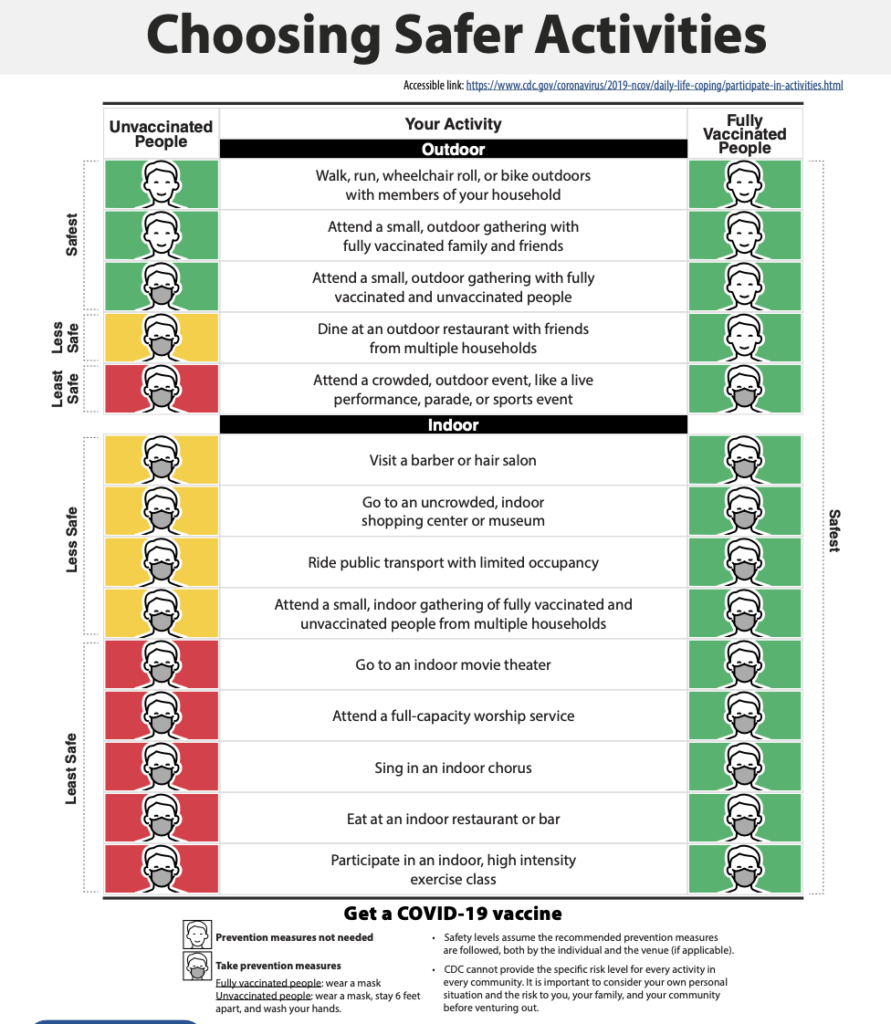
- Data from Brigham and Women’s Hospital in Boston found that patients who did not speak much, or any, English had a 35% greater chance of death.
- The U.S. has placed a travel ban on noncitizens traveling from India, effective this coming Tuesday.
- Pediatric influenza deaths remain at a staggeringly low number of one this season.
- A new CDC study shows that antibodies have been detected in most MERS (a similar coronavirus) survivors at 6 years post-infection.
- According to a CDC report, among farmworkers employed by a fruit grower in Washington, SARS-CoV-2 incidence was higher among those living in the community (12%) than among those living in congregate temporary housing (4%). Incidence was higher among farmworkers packing and sorting fruit indoors (28%) than among those working alone or in small groups indoors or working outdoors (6%–10%).
It has now been over 100 days of the Biden administration and immense progress has been made on the vaccination rollout. In 100 days, an impressive 220.8 million shots were put in arms, a remarkable achievement.
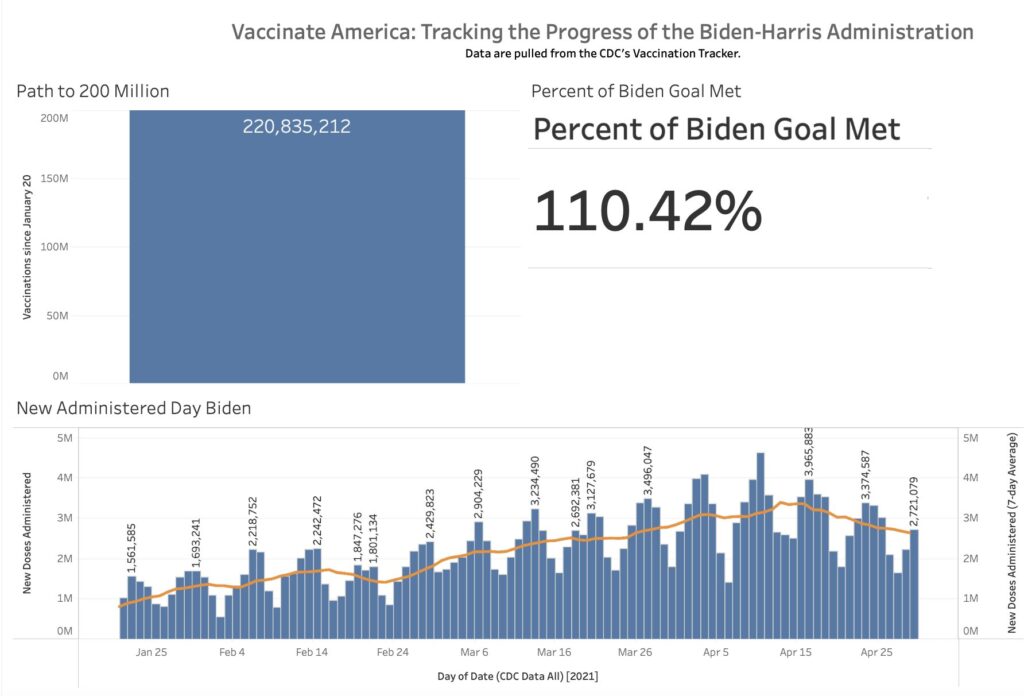
We have completed another week of the vaccine rollout and we continue to receive good news: We are seeing evidence that vaccinations are helping the U.S. stay ahead of variants and turn the corner on the pandemic. “I think we’ve hit a tipping point,” Brown University School of Public Health Dean Dr. Ashish Jha told NPR. However, as I wrote in a Twitter thread on Friday, challenges remain. While the Johnson & Johnson vaccine has now been unpaused, the increase in vaccinations has not yet shown up in the data. New J&J doses administered are starting to creep up, albeit slightly. In some parts of the country, the J&J vaccine has regained popularity. On Tuesday in Bloomington IN, 1,355 people at a mass vaccination site chose J&J, while 407 took the Pfizer vaccine. The “one and done” appeal is huge.
Daily vaccinations are down 11% from last Thursday, with only 10 states reporting an increase in average daily vaccination pace. However, it is not just doses administered that have fallen. Some areas of the country have declined vaccine shipments due to lack of demand. In some states in the South, new doses delivered have decreased dramatically.
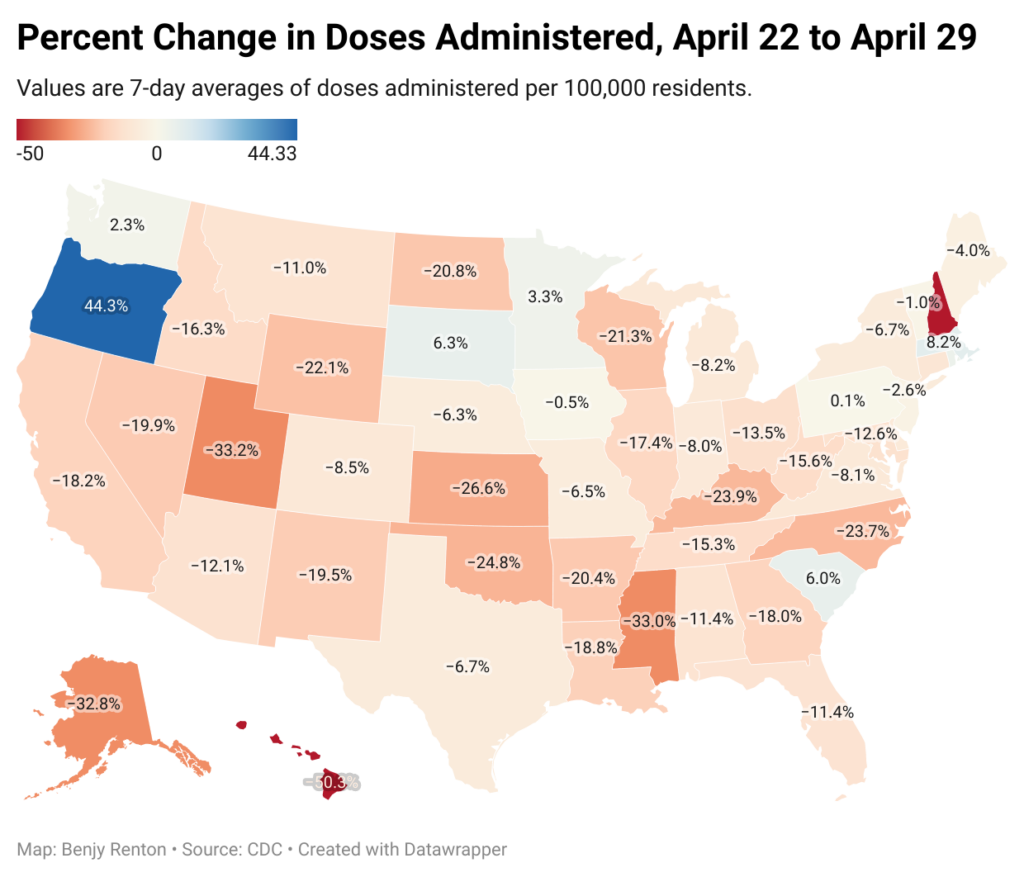
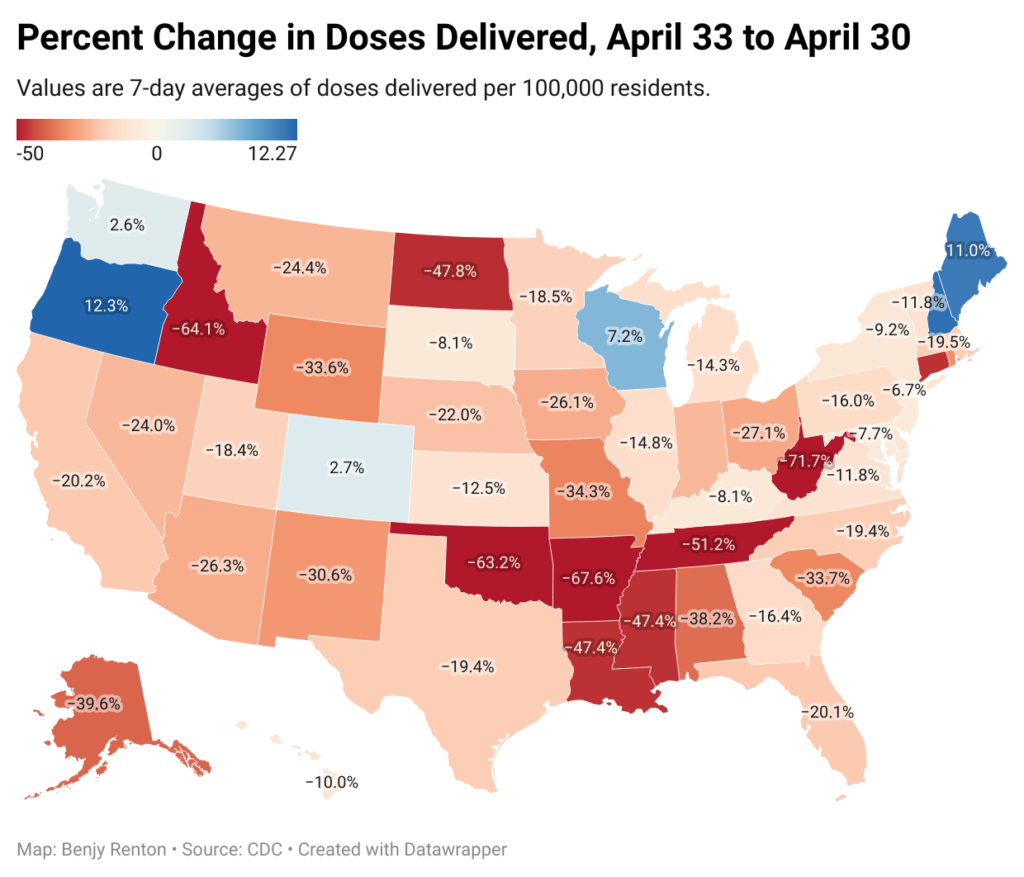
“From big swings to short strokes” defines the next phase of the vaccine rollout. The White House now plans on leveraging the power of the federal pharmacy program to increase the accessibility of vaccines to Americans. Appointments are now abundant across much of the country and in one of Philadelphia’s largest vaccination sites, waiting chairs are empty.
The Pennsylvania Convention Center vaccination site is not busy. If you haven’t gotten a shot yet and you live in Philly, the time is now! pic.twitter.com/Owjp84WtRP
— Jason Laughlin (@jasmlaughlin) April 29, 2021
In the U.S., 113.2 million doses were distributed in the month of April alone, bringing the total doses distributed to over 300 million. During that time, nearly 90 million doses were administered.
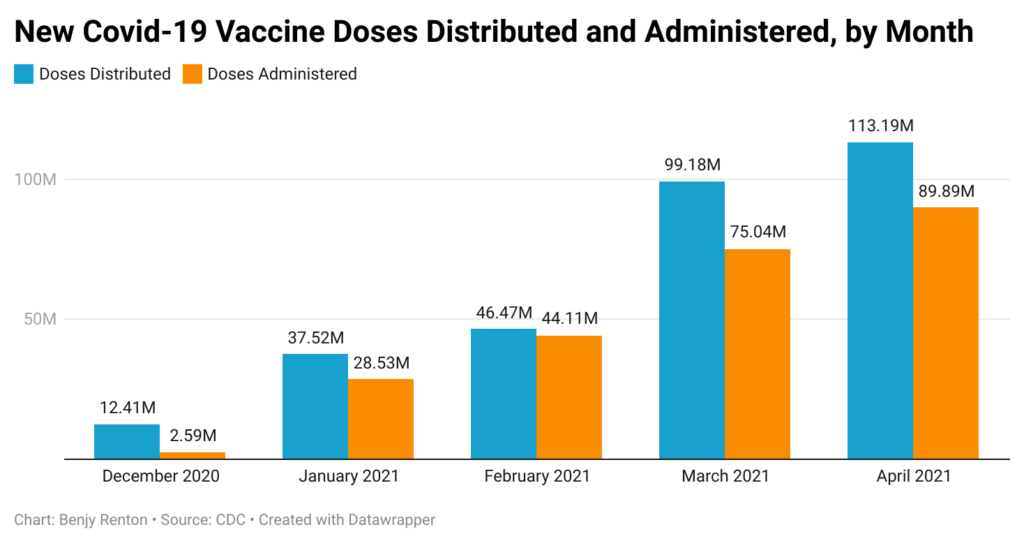
A few other updates on vaccines:
- American tourists who have been fully vaccinated against Covid-19 will be able to visit the European Union over the summer.
- The CDC has posted new data on vaccine breakthrough infections. As of April 26, out of 95+ million fully vaccinated, there have been 9,245 breakthrough infections (0.009%), 594 symptomatic hospitalizations and 112 Covid-19 deaths.
- The latest New York City vaccine data show that vaccination rates continue to be higher in more wealthy and white neighborhoods with lower cumulative infection rates.
- According to a Mayo Clinic study, the Pfizer and Moderna vaccines were 78-91% effective after one dose and 96-98% effective after two doses.
- West Virginia will begin offering $100 savings bonds to people aged 16 to 35 as an incentive to get vaccinated.
- “Instead of talking up hesitancy, it’s time to talk about what motivates people to get vaccinated and identify the ongoing barriers,” Brown University’s Stefanie Friedhoff writes. “The health and public health communities need to continue the hard work of making vaccines ubiquitous.”
- According to new CDC guidance, fully vaccinated patients/residents in nursing homes can participate in communal dining/activities/visitation without use of masks or physical distancing.
- In this week’s Covidiot of the Week, podcast host Joe Rogan says that “healthy” young people do not need to worry about the Covid-19 vaccine. This is utterly false.
- New research from the UK shows that those who do become infected 3 weeks after receiving one dose of the Pfizer-BioNTech or AstraZeneca vaccine were between 38% and 49% less likely to pass the virus on to their household contacts than those who were unvaccinated.
- “We can’t reach the Covid-19 finish line with only half the herd,” Dr. Jerome Adams, Trump’s surgeon general, writes in The Washington Post. “So I’m calling on him to loudly and proudly tell his supporters that he got vaccinated and they should too.”
- As U.S. News and World Report’s Chelsea Cirruzzo reports, the resumption of the Johnson & Johnson vaccine is critical to reaching the homeless population due to its one-shot nature.
- According to a CDC report, the Pfizer and Moderna vaccines were 94% effective against Covid-19 hospitalization among fully vaccinated adults and 64% effective among partially vaccinated adults aged ≥65 years.
- A ProPublica analysis of county data maintained by the U.S. Centers for Disease Control and Prevention shows that early attempts to prioritize people with chronic illnesses like heart disease, diabetes and obesity have faltered.
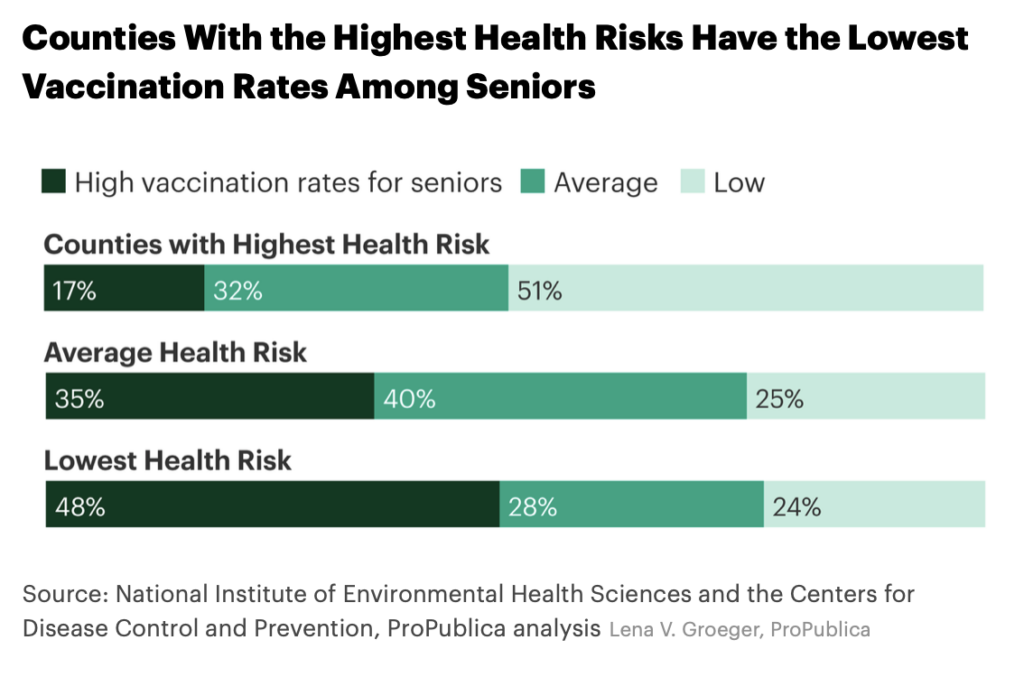
- Alaska Governor Mike Dunleavy has offered Covid-19 vaccines to residents of the small British Columbia town of Stewart, with hopes it could lead the Canadian government to ease restrictions between Stewart and the tiny Alaska border community of Hyder.
- There are promising data that vaccines will have some degree of efficacy against the variant discovered in India (B.1.617).
- New research published in PNAS suggest that text messages sent prior to a primary care visit can boost vaccination rates by an average of 5%.
- According to a study published in The Lancet, in patients with cancer, one dose of the Pfizer vaccine yields poor efficacy.
- Uber users will see a new “Vaccine” option in their Uber app and can choose to schedule an appointment at Walgreens. Users will have the option to reserve a ride to the appointment by scheduling a pickup time and location, all in the app.
- Moderna has announced that its vaccine can be stored at refrigerator temperatures for up to three months rather than frozen.
- In Middlebury, Vermont, the nonprofit Open Door Clinic has mobilized a van and a team of medical professionals and Spanish-speaking volunteers to vaccinate 350 farmworkers at 50 farms. Now, 98% of the county’s farmworkers have received at least one dose.
- The Biden administration launched a website and text line on Friday to help people find Covid-19 vaccines near where they live. You can now go to vaccines.gov/search or text your ZIP code to 438829 to find a vaccination site near you.
- New survey results published in Time magazine show why vaccinated people chose to get vaccinated.
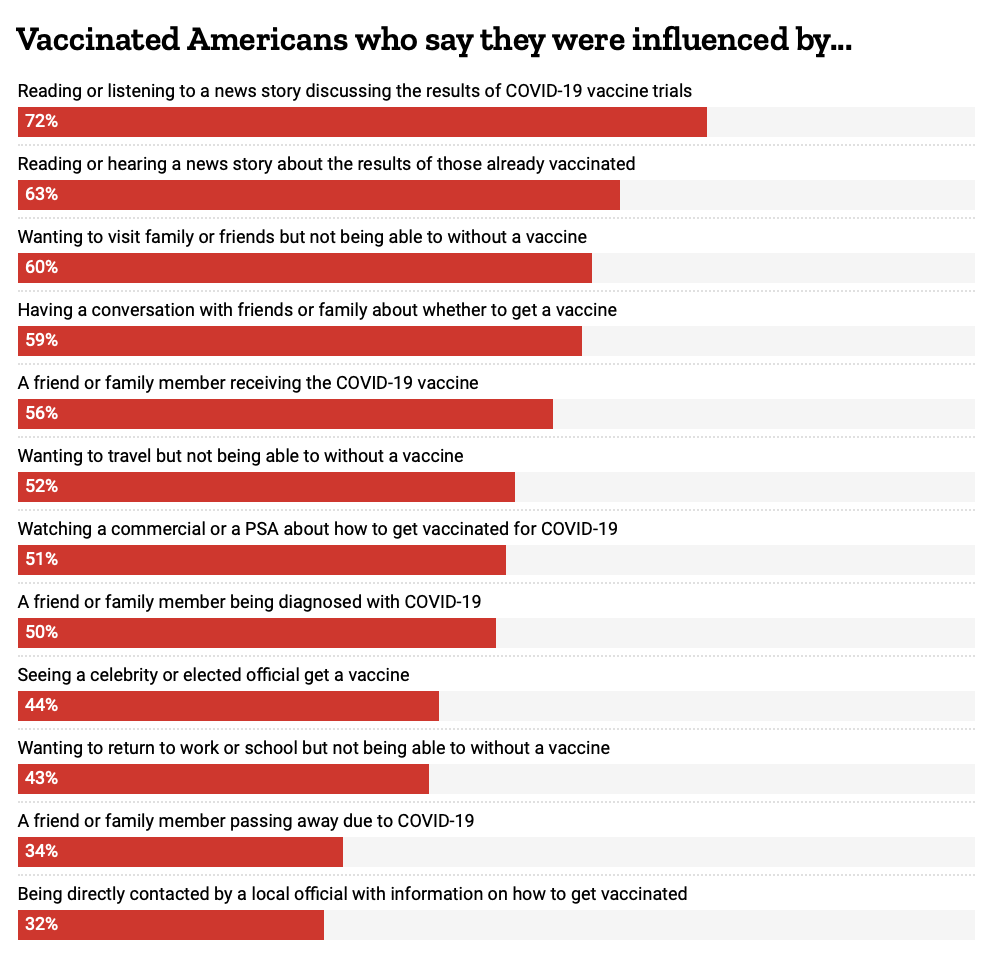
Let’s move on to our discussion of higher education.
Higher education
This week, the conversation continues to center around vaccine mandates. The Chronicle of Higher Education has tracked 190 campuses that have announced vaccination requirements for the fall. These decisions so far are deeply political — only 15 are located in states that voted for Trump in 2020. Of those 15, just one, Cleveland State University in Ohio, is a public university. It is possible that after May 1, the date when seniors are expected to commit to their colleges and submit deposits, more colleges will announce vaccination requirements. Iowa State University will strongly encourage but not require individuals to be vaccinated due to a bill in the Iowa Legislature that is expected to pass, which will bar universities from mandating vaccines. The American College Health Association now recommends Covid-19 vaccination requirements for all on-campus college and university students for fall semester 2021. We will continue to monitor more vaccination requirements as they are announced.
Here’s a roundup of this week’s higher ed news:
- Colgate University sent pizza to its nearly 300 remote students so they could enjoy the college-town favorite New York Pizzeria from their homes.
- Foreign students from China, Iran, Brazil and South Africa will be exempt from pandemic travel bans and will be allowed back into the U.S. as long as they have valid F-1 or M-1 visas.
- The University of Maryland is one of a few schools to report vaccination data on its dashboard. 79% of its students have at least one dose and 47% are fully vaccinated.
- The University of Virginia has updated its guidance in line with the CDC, saying that fully vaccinated individuals are permitted to gather outdoors without masks.
- According to a new working paper published by Davidson College’s College Crisis Initiative, there was a strong association between a school’s fall plans and those of its peer schools.
- For many colleges and universities, plans for in-person graduations are still in flux.
The Good Stuff
Let’s roll the clips of the good stuff. In my usual tradition, I feature my favorite stories from the week. Here are my Top 10.
- The New York Times sent photographers across the country to document the reunions between family members. For many, it was the first time they were able to be together, hold hands and hug in more than a year.
- Rest in peace to former astronaut Michael Collins, who piloted the command module during the famous Apollo 11 mission.
- The New York Times published an in-depth interactive diving into how the Pfizer vaccine is made.
- CNN marks President Biden’s first 100 days with a retrospective of his accomplishments.
- The popularity of chicken — from sandwiches and tenders to nuggets and wings — is fueling such demand for fried poultry that America is starting to run short.
- This weekend is the 10th anniversary of the raid that killed Osama bin Laden. For POLITICO, Garrett Graff reconstructs the week in an oral history.
- Science at the Oscars! Devising this year’s Academy Awards protocols was Dr. Anne Rimoin, epidemiologist at UCLA’s Fielding School of Public Health and Middlebury Class of 1992.
- Missing out on Thin Mints in the pandemic? A Google affiliate is using drones to deliver Girl Scout cookies to people’s doorsteps in a Virginia community.
- Starting on the day Joe Biden took office, veteran photographer Stephen Voss roamed the halls and streets of D.C. to capture the strangeness of life in Washington at the dawn of a new presidential era.
- Many truckers depend on the companionship of dogs, cats, birds, pigs — or even a hedgehog.
Conclusion
As the U.S. continues to excel at vaccinations, less willing Americans remain the key issue between now and a healthy summer. Areas of the country, particularly in the South, still lag in vaccination rates. This next phase of the rollout must focus on increasing access and addressing people’s vaccination concerns to combat hesitancy. Every vaccination counts. At the same time, the U.S. now must take a renewed stance and commit to vaccinating the world.
I’d like to thank all the student journalists with whom I have the pleasure of working. In the next weeks and months ahead, they will become vital in chronicling their colleges’ paths forward for the spring and beyond. Support their work by reading it.
My best to all for good health.
Like what you see? Don’t like what you see? Want to see more of something? Want to see less of something? Let me know in the comments. And don’t forget to subscribe to the weekly newsletter!
For more instant updates, follow me on Twitter @bhrenton.

